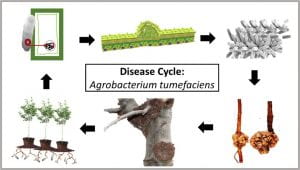What is Apple Crown Gall?
Crown gall is a bacterial disease in apple that is caused solely by the species, Agrobacterium tumefaciens. This disease has been found across 93 families and 750 different species of plants, including many commercially grown fruit tree crops like apples, pears, peaches, and cherries. It poses a serious economic threat to tree crop growers as a common bacterial disease found in commercial orchards. The main concern with crown gall is its ability to kill the plant through structural damage, stem girdling or secondary infections. These negative consequences also result in a loss of yield per tree costing money in lost product and an increase in management related labor costs.
What does Apple Crown Gall look like?
Crown gall starts as swellings and growing tumors of vascular tissue that stem from rapidly dividing regions of cells. These developing galls can be soft or hard, depending on the density of vascular tissue in the affected area. They are also regularly described as wart looking structures. The protruding galls are often discolored compared to the surrounding bark tissue. Fresh young galls will look lighter in color. Older, larger galls are more often darker in color compared to normal bark. The increased cell division and growth of galls is faster than the epidermal layers can handle and will result in cracking of bark. This disruption of the bark exposes lower cambium layers and makes the plant more vulnerable to new secondary infections. These symptoms can be found on the roots, the trunk, and along the upper branches. When the number and size of the galls increases, there can be pinching of xylem and phloem that can restrict the movement of nutrients and water across the plant. This can result in symptoms of generalized decline, like canopy thinning and leaf yellowing.
Where does Apple Crown Gall come from?
Crown gall is adaptive and can live both freely in the soil as well thrive within a plant host. The difficulty of crown gall is that it is naturally found in soils all over the world and affects a very wide range of hosts that can act as alternative hosts in your orchard. Bacteria, in general, do not possess the mechanisms to penetrate the host plant actively, instead, the entrance points are typically wounded tissue that provide a passive opening for entry. This wounding can be caused by mechanical damage from tilling or sprayers, winter damage as well as pests like nematodes or aphids that specialize in penetrating the host epidermis. Another major mode of spread is through grafting and budding on to infected stock. The disease cycle for Agrobacterium tumefaciens is key to ensuring proper management of this difficult apple disease. Disrupting one element of this cycle can help keep the damage from Agrobacterium to a minimal and manageable amount.
Figure: The disease cycle of the pathogen, Agrobacterium tumefaciens. The bacteria grow and thrive in contaminated soil where it makes contact with plant roots and begin infection (bottom-left). The bacteria enter the root tissue and bind to the cells where the Ti-plasmid is injected to incorporate the plasmid DNA into the host genome and edit the sequence to favor the pathogen (top-left). The introduced bacterial DNA cause rapid plant cell growth and begin forming a tumor that will benefit pathogen replication (top-middle). The number of bacteria increases exponentially, forming young galls (top-right/bottom-right). The young galls grow into large, structurally damaging galls protruding from the bark (middle-bottom). The thriving bacteria overwinter in the soil and continue infections the following season (bottom-left).
How do I prevent and control Apple Crown Gall?
- Due to pervasiveness of the pathogen, diligent management is required to prevent long lasting contamination
- Antibiotic sprays are NOT generally recommended, due to little pathogen exposure during infection
- Ensure purchase of crown gall free (certified) rootstock that has been tested for the bacteria in the nursery before establishment in the orchard
- Remove trees that show worsening symptoms and properly destroy the tissue to prevent it from becoming a new source of inoculum
- Prevent alternate hosts from sustaining outbreaks by conducting diligent weed management
